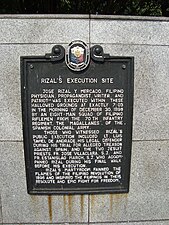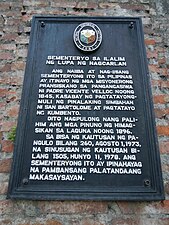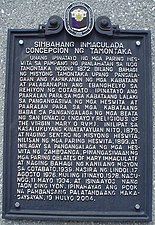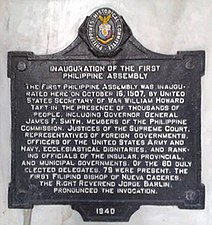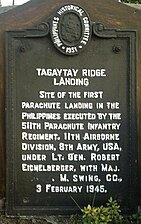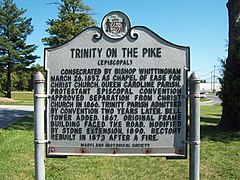Commemorative plaque: Difference between revisions
Ryomaandres (talk | contribs) |
Rescuing 1 sources and tagging 0 as dead. #IABot (v1.6.1) (Balon Greyjoy) |
||
| Line 134: | Line 134: | ||
== Theft == |
== Theft == |
||
As the price of scrap metal has increased plaques have been the target of [[Metal theft|metal thieves]] wishing to resell the metal for cash.<ref>{{cite web |last=Hightower |first=Eve |url= |
As the price of scrap metal has increased plaques have been the target of [[Metal theft|metal thieves]] wishing to resell the metal for cash.<ref>{{cite web |last=Hightower |first=Eve |url=http://www.modbee.com/local/story/150813.html |title=Stanislaus supervisor wants recycling ordinance used to fight metal theft regionally |publisher=The Modesto Bee |date=13 December 2007 |accessdate=17 November 2010 |deadurl=yes |archiveurl=https://web.archive.org/web/20080223210612/http://www.modbee.com/local/story/150813.html |archivedate=23 February 2008 |df=dmy-all }}</ref> |
||
== Awards == |
== Awards == |
||
Revision as of 21:49, 7 January 2018



A commemorative plaque, or simply plaque, or in other places referred to as a historical marker or historic plaque, is a plate of metal, ceramic, stone, wood, or other material, typically attached to a wall, stone, or other vertical surface, and bearing text or an image in relief, or both, to commemorate one or more persons, an event, a former use of the place, or some other thing. Many modern plaques and markers are used to associate the location where the plaque or marker is installed with the person, event, or item commemorated as a place worthy of visit.[1] A monumental plaque or tablet commemorating a deceased person or persons, can be a simple form of church monument. Most modern plaques affixed in this way are commemorative of something, but this is not always the case, and there are purely religious plaques, or those signifying ownership or affiliation of some sort. A plaquette is a small plaque, but in English, unlike many European languages, the term is not typically used for outdoor plaques fixed to walls.
Historical
Benin Kingdom
The Benin Empire, which flourished in present-day Nigeria between the thirteenth and nineteenth centuries, had an exceedingly rich sculptural tradition. One of the kingdom’s chief sites of cultural production was the elaborate ceremonial court of the Oba (divine king) at the palace in Benin. Among the wide range of artistic forms produced at the court were rectangular brass or bronze plaques. At least a portion of these plaques, which were mainly created from the thirteenth through sixteenth centuries, commemorate significant persons and events associated with the Oba’s court,[2][3] including important battles during Benin’s sixteenth century expansionary period.[4]
Medieval Europe
Brass or bronze memorial plaques were produced throughout medieval Europe from at least the early thirteenth through the sixteenth centuries as a form of sepulchral memorial generally inset into the walls of churches or surfaces of tombs. Surviving in great numbers, they were manufactured from sheet brass or latten, very occasionally coloured with enamels, and tend to depict highly conventional figures with brief inscriptions.[5][6]
Modern
Historical markers are put on display by the owners of sites listed by national agencies concerned with historic preservation such as the National Trust for Historic Preservation and the National Register of Historic Places[7] (in the United States), the National Trust for Places of Historic Interest or Natural Beauty[8] (in the United Kingdom), An Taisce[9] (in Ireland), National Historical Commission of the Philippines (in the Philippines), and the National Trusts of other countries.
Other historical markers are created by local municipalities, non-profit organizations, companies, or individuals. In addition to geographically defined regions, individual organizations, such as E Clampus Vitus or the American Society of Mechanical Engineers, can choose to maintain a national set of historical markers that fit a certain theme.[10]
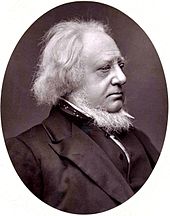
The Royal Society of Arts established the first scheme in the world for historical commemoration on plaques in 1866.[11]
The scheme was established under the influence of the British politician William Ewart and the civil servant Henry Cole.[12] The first plaque was unveiled in 1867 to commemorate Lord Byron at his birthplace, 24 Holles Street, Cavendish Square. The earliest historical marker to survive, commemorates Napoleon III in King Street, St James's, and was also put up in 1867.[13]
The original plaque colour was blue, but this was changed by the manufacturer Minton, Hollins & Co to chocolate brown to save money.[14] In 1901, the scheme was first taken over by the local government authority - the London County Council.[15]
Austria
Belgium
Canada
Chile
France
Germany
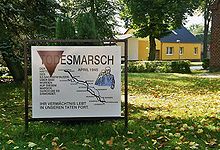
Hong Kong
- Declared monuments of Hong Kong
- List of Grade I historic buildings in Hong Kong
- List of Grade II historic buildings in Hong Kong
- List of Grade III historic buildings in Hong Kong
Italy
Netherlands
New Zealand
Singapore
Switzerland
- Kulturgüterschutz — or: Protection des biens culturels; Cultural heritage protection in Switzerland; or Protezione dei beni culturali
Philippines
Historical markers or panandang pangkasaysayan are cast-iron plaques installed all over the Philippines that commemorate people, places, personalities, structures, and events. They are installed by the National Historical Commission of the Philippines. This started in 1933, with NHCP's predecesor, the Philippine Historical Research and Markers Committee, which initially only marked antiquities in Manila. There are more than 1,330 markers to date. Markers have also been installed in areas outside the country to commemorate important Filipino personalities and events abroad. The plaques themselves are permanent signs installed in publicly visible locations on buildings, monuments, or in special locations.
- Historical markers all over Philippines
United Kingdom

Blue plaques are the principal type of historical markers found throughout England and are the closest thing there is to a historical marker system in that country. An example is the blue plaque scheme run by English Heritage in London, although these were originally erected in a variety of shapes and colors. The National Trust (which is a non-profit charity organization unlike English Heritage and English Heritage properties) has its own similar markers as well.[16][17]
However, not all historical markers in the United Kingdom are blue, and many are not ceramic. There are commemorative plaque schemes in Bath, Edinburgh, Brighton, Liverpool, Loughton, and elsewhere—some of which differ from the familiar blue plaque. A scheme in Manchester uses color-coded plaques to commemorate figures, with each of the colors corresponding to the person's occupation. The Dead Comics' Society installs blue plaques to commemorate the former residences of well-known comedians, including those of Sid James and John Le Mesurier. In 2003, the London Borough of Southwark started a plaque scheme which included living people in the awards. Even in London, the Westminster City Council runs a green plaque scheme which is run alongside that of the blue plaque scheme administered by English Heritage. Other schemes are run by civic societies, district or town councils, or local history groups, and often operate with different criteria.[16][17] In 2010, British tabloid The Sun placed a red coloured plaque outside the Snappy Snaps store in Hampstead, North London where singer George Michael crashed in the early hours of Sunday 4 July 2010. The newspaper stated it planned to put similar plaques in sites around the UK to mark events that had proved popular in the UK Tabloid Press.[18]
In England, the London blue plaques scheme, which is administered by English Heritage, has been running for over 140 years and is thought to be the oldest of its kind in the world. Plaques are attached to buildings to commemorate their association with important occupants or events.[19]
A range of other commemorative plaque schemes, which are typically run by local councils and charitable bodies, exists throughout the United Kingdom. These tend to use their own criteria for determining the eligibility to put up a plaque. A list of schemes currently operating in England is available on the English Heritage website.
After the First World War, the families of British and British Empire (now Commonwealth) service men and women killed during the conflict were presented with bronze Memorial Plaques. The plaques, of about 125 millimetres (4.9 in) in diameter, were designed by the eminent sculptor and medallist, Edward Carter Preston.
See also:
- Blue plaques programme — all U.K.
- List of blue plaques
- Statutory List of Buildings of Special Architectural or Historic Interest
- National Trust for Places of Historic Interest or Natural Beauty — England, Wales, and Northern Ireland.
- National Trust for Scotland — Scotland
United States
In the United States, various state governments have commemorative plaque schemes usually using the name historical markers. The National Trust for Historic Preservation or the U.S. Government, through the National Register of Historic Places, can bestow historical status.
State programmes, such as the California Register of Historical Resources allows designated sites to place their own markers.
The criteria and circumstances through which a party administers the distribution of historical markers varies. For example, the "Preservation Worcester" program in Worcester, Massachusetts allows a person to register their house or other structure of least fifty years of age if the building is well preserved, with retention of its original character and importance to the architectural, cultural or historical nature of the local neighborhood. One then pays a fee ($185 to $225) to receive the historical marker itself.[20]

In the same state, the Boston neighborhood of Charlestown, Massachusetts has its own local association to administer historical markers.[21] Other historical markers in and around Boston are administered by agencies such as The Bostonian Society[22] or are associated with sites such as those along the Freedom Trail, the Black Heritage Trail, and the Emerald Necklace.[23]
Other examples of mostly locally generated historical markers in the United States include the plaque outside the Alaska Governor's Mansion made by the Alaska Centennial Commission's historical markers program,[24] the historical markers of State Historic Marker Council in Florida,[25] the markers placed by various agencies in Georgia (of which one source mentions 3,292 different historical markers[1]), in Indiana, where it is illegal to create a historical marker in the "state format" without first getting official approval from that state's historical bureau,[26] historical markers in Kansas erected by the Kansas Historical Society and the Kansas Department of Transportation,[27] the Roadside Historic Marker Program in Maryland administered by the Maryland Historical Trust,[28] the State Historic Marker Program of New York (begun in 1926 to commemorate the Sequicentennial of the American Revolution),[29] the historic markers placed as recently as 2008 in Sussex County, New Jersey,[30] the New Mexico historical markers printed in white letters on a brown background by the New Mexico Department of Transportation,[31] the historical markers of North Carolina (the Historical Publications Section of the state Office of Archives and History publishes a Guide to North Carolina Highway Historical Markers),[32] the more than 1200 historical markers of Ohio (all of which are now made in a Marietta, Ohio workshop),[33] and over 550 official state markers in Wisconsin.[34]
See also:
- National Register of Historic Places (NRHP)
- National Trust for Historic Preservation
- Historical markers posted at U.S. state and/or municipal levels (examples):
- California Historical Landmark — of statewide historical significance, by state
- New York State Historic Markers — of statewide historical significance, by state
- California Points of Historical Interest — of local (city or county) significance, by state
- Los Angeles Historic-Cultural Monument — by city
- San Francisco Designated Landmarks — by city
- New York City Landmarks Preservation Commission Designated Landmarks — by city
- North Carolina Highway Historical Marker Program, part of the North Carolina Department of Cultural Resources -- by state
Theft
As the price of scrap metal has increased plaques have been the target of metal thieves wishing to resell the metal for cash.[35]
Awards
Plaques or, more often, plaquettes, are also given as awards instead of trophies or ribbons. Such plaques usually bear text describing the reason for the award and, often, the date of the award.
Gallery
Some sample images of historical markers from different places:
-
The plaque in the Hong Kong Park commemorating the park's opening by the Governor of Hong Kong in 1991
-
An award plaque made of wood with a printed metal plate and a medallion
-
An example of a plaque in Canberra, Australia
-
Plaque showing the historical coat of arms of Wolverhampton, England, before 1898
-
First World War memorial plaque
-
Second World War memorial plaque
-
Plaque for You Chung Hong, California lawyer, in Chinatown, Los Angeles, California, 2012
-
A commemorative plaque from the Möhne Dam in Germany which was brought to Australia as a war trophy on display at the Australian War Memorial
-
The Idaho Statesman Building, built in 1909, was the site of the first computer in Boise, Idaho, the UNIVAC 120, installed in 1957
References
- ^ a b "Historic Markers Across Georgia". Latitude 34 North. Retrieved 31 October 2008.
- ^ Ezra, Kate (1992). Royal Art of Benin: The Perls Collection in the Metropolitan Museum of Art. New York: Metropolitan Museum of Art. ISBN 0810964147.
- ^ "Benin plaque: the oba with Europeans". The British Museum. Retrieved 27 June 2015.
- ^ Plankensteiner, Barbara (22 December 2007). "Benin—Kings and Rituals: Court Arts from Nigeria". African Arts. University of California. ISSN 0001-9933. Retrieved 27 June 2015.
- ^ Chisholm, Hugh, ed. (1911). . Encyclopædia Britannica. Vol. 4 (11th ed.). Cambridge University Press.
- ^ Badham, Sally; Norris, Malcolm (1999). Early Incised Slabs and Brasses. London: Society of Antiquaries.
- ^ "National Register of Historic Places". National Park Service. Archived from the original on 9 July 2008. Retrieved 31 October 2008.
- ^ "The National Trust". Retrieved 31 October 2008.
- ^ "An Taisce". National Trust for Ireland. Retrieved 31 October 2008.
- ^ "Making their markers". The News & Observer. Archived from the original on 10 February 2009. Retrieved 31 October 2008.
{{cite web}}: Unknown parameter|deadurl=ignored (|url-status=suggested) (help) - ^ "Blue Plaques". English Heritage. Retrieved 16 June 2011.
- ^ Hansard vol 172 17 July 1863 quoted in 'The commemoration of historians under the blue plaque scheme in London' by author Howard Spencer
- ^ "History of the Blue Plaques Scheme". English Heritage. Retrieved 16 June 2011.
- ^ "About blue plaques". Royal Borough of Kensington and Chelsea. Retrieved 16 June 2011.
- ^ "The Blue Plaque Design". English Heritage. Retrieved 16 June 2011.
- ^ a b Markeroni.com Archived 15 January 2016 at the Wayback Machine, Information about historical markers and historical plaques, and historic preservation in England, British Isles.
- ^ a b "English Heritage". English Heritage. 26 October 2011. Retrieved 30 November 2011.
- ^ "The Sun marks the dented shop front where stoned George Michael crashed" Archived 3 March 2016 at the Wayback Machine, The Sun, accessed 2010-09-18.
- ^ "History of the Blue Plaques Scheme". Retrieved 30 July 2012.
- ^ "Preservationworcester.org". Preservationworcester.org. Archived from the original on 6 November 2011. Retrieved 30 November 2011.
{{cite web}}: Unknown parameter|deadurl=ignored (|url-status=suggested) (help) - ^ "Charlestownpreservation.org". Charlestownpreservation.org. Archived from the original on 5 October 2011. Retrieved 30 November 2011.
{{cite web}}: Unknown parameter|deadurl=ignored (|url-status=suggested) (help) - ^ 2007 Catalogue For Philanthropy
- ^ "Boston National Historic Park". Nps.gov. 17 November 2011. Retrieved 30 November 2011.
- ^ "Alaska Historic Markers". Waymarking.com. 31 January 2011. Retrieved 30 November 2011.
- ^ Florida Heritage & Preservation Archived 20 August 2006 at the Wayback Machine
- ^ "Historical Marker FAQs". In.gov. 16 June 2009. Archived from the original on 15 February 2009. Retrieved 30 November 2011.
{{cite web}}: Unknown parameter|deadurl=ignored (|url-status=suggested) (help) - ^ "Kansas Historical Markers". Kshs.org. Retrieved 30 November 2011.
- ^ Maryland Historical Trust [dead link]
- ^ "New York State Museum". Nysm.nysed.gov. 1 December 1998. Archived from the original on 5 September 2015. Retrieved 30 November 2011.
{{cite web}}: Unknown parameter|deadurl=ignored (|url-status=suggested) (help) - ^ "Sussex County News and Information". Sussex.nj.us. 14 May 2008. Retrieved 30 November 2011.
- ^ New Mexico Department of Transportation [dead link]
- ^ News Observer Archived 10 February 2009 at the Wayback Machine (26 July 2006)
- ^ "Manufacturing Ohio's Historic Markers". Touring-ohio.com. Archived from the original on 2 October 2011. Retrieved 30 November 2011.
{{cite web}}: Unknown parameter|deadurl=ignored (|url-status=suggested) (help) - ^ "Wisconsin Historical Society". Wisconsinhistory.org. Retrieved 30 November 2011.
- ^ Hightower, Eve (13 December 2007). "Stanislaus supervisor wants recycling ordinance used to fight metal theft regionally". The Modesto Bee. Archived from the original on 23 February 2008. Retrieved 17 November 2010.
{{cite web}}: Unknown parameter|deadurl=ignored (|url-status=suggested) (help)
Bibliography
- James Loewen, Lies Across America: What Our Historic Sites Get Wrong, 1999.
- English Heritage, Blue Plaques: A Guide to the Scheme, 2002
- Nick Rennison, The London Blue Plaque Guide, 2003
- Derek Sumeray, Discovering London Plaques
- Derek Sumeray, Track the Plaque, 2003

